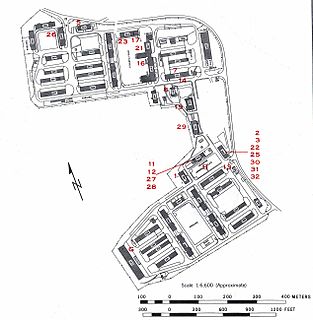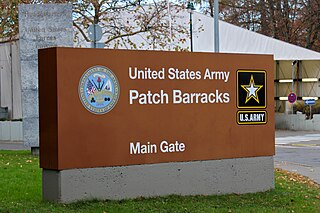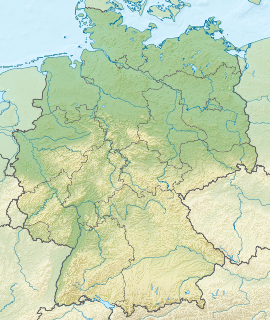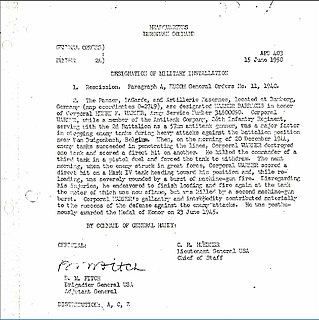 W
WCamp Grohn was a military base of the U.S. Army on the outskirts of Bremen, Germany after the end of World War II from 1945 to 1954. Camp Grohn was originally built in 1936 as Flak Kaserne and housed the first battalion of the Luftwaffe's 26th Anti-Aircraft Artillery Regiment prior to the outbreak of World War II. Following the defeat of Germany in the war, the U.S. Army took over the military base and renamed it Camp Grohn after the part of Bremen in which the camp was located. Camp Grohn was in a small, joint American/British sector in northern Germany called the Bremen Enclave, which included the ports of Bremen and Bremerhaven.
 W
WColeman Kaserne was a United States Army base located in the German city of Gelnhausen, located in the state of Hessen. Coleman Kaserne should not be confused with the U.S. Army "Coleman Barracks" which is located in Mannheim. Kaserne is a German word for barracks.
 W
WEmery Barracks was a former military garrison located near Veitshöchheim, a municipality in the district of Würzburg, in Bavaria, Germany. It was situated on the right bank of the Main, 4 kilometres (2 mi) northwest of Würzburg. It was active as a military base from the 1930s through 1992, and was later used to house refugees and asylum seekers. It was bounded on the northwest by Albert-Einstein-Straße, to the southwest by B27, to the southeast by Pfaffenbergstraße, and to the northeast by Alfred-Nobel-Straße.
 W
WFaulenberg Kaserne is a former military garrison, located near Grombühl, east of the City of Würzburg, in Franconia, Germany. The kaserne, built in the region of the former Faulenberg vineyard, was bordered on the south by Nürnberger Straße, on the west by Matthias-Thoma-Straße and on the north on the outer Aumühlstraße and Kürnach. To the east is Ohmstraße. It was active as a military base between 1877 and 2007.
 W
WFerris Barracks is a former US military garrison located in Erlangen, a Middle Franconian city in Bavaria, Germany. It was active as a US military base between 1945 and 1994. The facility was occupied after World War II and designated Ferris Barracks in honor of Second Lieutenant (2LT) Geoffrey Cheney Ferris. Ferris Barracks was closed on 28 June, 1994, and officially turned over to the German government. Though largely dismantled, certain historic buildings and monuments have been preserved and converted for alternative use. The area has undergone extensive construction and is now referred to as Röthelheimpark.
 W
WFlak-Kaserne Ludwigsburg was a military barracks, originally belonging to the German Army, and later occupied by the United States Army. It lies in the city of Ludwigsburg, in south-west Germany near Stuttgart.
 W
WGablingen Kaserne is a former military facility in Gablingen near Augsburg, Germany, which was closed in 1998. Its primary use was signals intelligence collection during the Cold War.
 W
WThe Ernst-von-Bergmann-Kaserne, before called Warner Kaserne by the US Army (1950-1968), has been a military facility in Munich, Germany, which was built by the architect Oswald Bieber between 1934 and 1936. The current name was given in honor of professor Ernst von Bergmann.
 W
WHindenburg Kaserne, also known as Hindenburg Barracks, was a former military garrison, located near in the Zellerau district in the city of Würzburg, in Franconia, Germany. The kaserne, was situated between Weißenburgstraße, Mainaustraße and Moscheeweg. It was active as a military base between 1935 and 1993.
 W
WKatterbach Kaserne is a United States Army facility in Germany, located in the village of Katterbach, about 3 miles east-northeast of Ansbach (Bavaria); about 250 miles south-southwest of Berlin.
 W
WKelley Barracks is a U.S. military installation and headquarters of United States Africa Command, and is a part of US Army Garrison Stuttgart in Stuttgart-Möhringen in Germany. The post is administered by IMCOM- Europe.
 W
WLarson Barracks was a former military garrison located near Kitzingen, in Bavaria, Germany, west of the Main River. It was active as a military base, first for Nazi Germany from 1936-1945 and then for the United States from 1945-2006 before being returned to the German government in 2007.
 W
WLucius D. Clay Kaserne, commonly known as Clay Kaserne, is an installation of the United States Army in Hesse, Germany. The kaserne is located within Wiesbaden-Erbenheim. It is named for General Lucius D. Clay. It is the home of the Army's 2d Theater Signal Brigade, 66th Military Intelligence Brigade and is the headquarters of the U.S. Army Europe (USAREUR), which oversees the 7th Army Training Command, 10th Army Air & Missile Defense Command and 21st Theater Sustainment Command. Clay Kaserne also maintains an airfield.
 W
WThe McGraw Kaserne is a former military installation in southern Munich, Germany, which was used by the U.S. Military during the occupation of Germany after World War II. The main building was one of the first ones in Germany to be built using steel frame technology. The kaserne was named after PFC Francis X. McGraw.
 W
WThe McNair Barracks was a US Army installation in Lichterfelde, a locality in southwest Berlin, Germany. The barracks were named after Lieutenant General Lesley J. McNair, an American Army officer who served in World War I and World War II and was killed in an infamous friendly fire incident on 25 July 1944 in the Battle of Normandy. The barracks housed the Infantry and Artillery units of the U.S. Army Berlin Brigade.
 W
WPanzer Kaserne is a U.S. military installation in Böblingen, Germany, part of US Army Garrison Stuttgart. The post is administered by United States Army Installation Management Command-Europe (IMCOM-Europe), a legacy from its use as an Army installation since just after World War II. Panzer also hosts the headquarters of United States Marine Corps Forces, Europe & Africa (MARFOREURAF) and various Special Operations units of the Army and Navy supporting EUCOM and AFRICOM.
 W
WPatch Barracks is a U.S. military installation in Stuttgart, Germany. It is named after U.S. Army General Alexander M. Patch.
 W
WRay Barracks was a United States Army installation in Friedberg, Germany until it was closed by the U.S. government in 2007 and returned to the German government. Located in the southern part of the city near the industrial area, the barracks had numerous facilities. The barracks included a firing range for personal weapons qualification, an Urban warfare training site, vehicle maintenance facilities and various recreation facilities. After World War II the barracks were named after First Lieutenant Bernard J. Ray, who was awarded the Medal of Honor for his actions during the Battle of Hurtgen Forest. Ray sacrificed himself to destroy a wire obstacle that was blocking his unit's path. The base was closed in August 2007.
 W
WShipton Kaserne is a small United States Army post outside of Ansbach, Germany. The post was built in the late 1980s, and is located in-between Katterbach and Ansbach, adjacent to Soldier's Lake and Urlas Housing and Shopping Complex. It was the home of the 412th Aviation Support Battalion from 2006 until its inactivation in 2015. Since its creation, Shipton Kaserne has been home to several units, including the 6th Battalion, 43rd Air Defence Artillery Regiment, 6/52 Air Defense Artillery, and the 601st Aviation Support Battalion.
 W
WWallace Barracks is a former German and U.S. Army installation in the Bad Cannstatt district of Stuttgart, Germany. It is located just below the Burgholzhof, near Robinson Barracks and the former Grenadier Kaserne on the site of a former Roman military camp commonly referred to in literature as Kastell Cannstatt.
 W
WWarner Barracks was a United States Army military base in the city of Bamberg, Bavaria, southern Germany. The base had been occupied by U.S. forces since the end of World War II. Elements of the U.S. Army’s 3rd Infantry Division and 45th Infantry Division entered the town on 13 and 14 April 1945. But before the war, this military site had a colorful history that goes hand-in-hand with Bamberg’s history, which began in the 10th century. Bamberg was originally a fort on a hill. The view enabled soldiers of the time to watch the city and guard it against possible attacks. In 973, the Duke of Bavaria gained control of the fort. The city and fort fell under Swedish Protestants’ control during the Thirty Years War when the Swedes engulfed the city and took it forcibly in 1634.